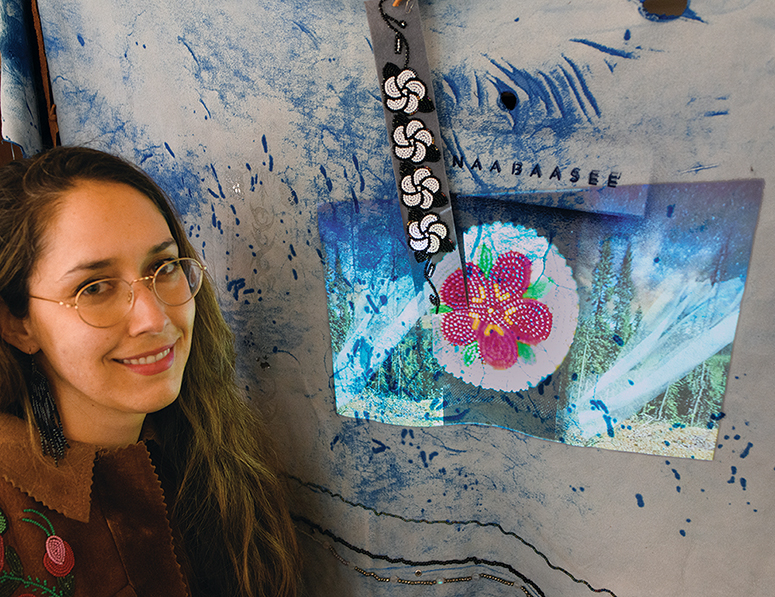Written by Olivia Amaya Ortiz.
Koyukon Athabascan creative, Janna Avner (she/her), joins the SAR Native Artist Fellowship community as its first practicing light artist. Using light as her primary medium, Avner seeks to reclaim romanticizations of landscape imagery and incorporate expansive interpretations of Indigeneity, perception, and the environment. Her pieces serve as visual metaphors that, at times, contain projections of beadwork and hologram recreations of the northern lights. Olivia Amaya Ortiz, IARC Educator, sat down with Janna to learn more about her work and her plans for her time in SAR’s Dubin Studio.
What will you be doing while at SAR?
I will make what I call prototypes, studies, and one potential design by the end of the residency in the form of paintings, sculpture, drawings, and software renderings. One piece is a do-it-yourself hologram of mixed materials, including birchwood and moosehide, and will house small digital video projectors. This residency allows me to experiment with a variety of materials (glass, plastic, bioplastic, hologram, and paint on canvas) and either project onto or through these mediums to mimic the aurora borealis of Alaska.

Detail of a painting by Janna Avner.
In your application, you noted that your goal as an artist is to study the symbolism of arctic light for Indigenous futurist concepts in paintings and light sculptures. Can you tell us more about how these concepts play out in your work?
In my understanding, Indigenous Futurisms developed in parallel to other science fiction-based movements, and within itself, developed pluralistically to span a range of interpretations, mediums, and genres. For this reason, “futurisms” is described in the plural and is a case-by-case basis, encompassing creative fiction novels of “first contact” on distant planets to present-day, eco-sustainable speculative arts movements related to the Earth’s land and resources. However, I feel what arguably binds the various Indigenous futurist expressions together is an emphasis on the psychological and the imaginative to incorporate Indigenous technologies. Indigenous futurist concepts expand how I think about my work and where I fit in as both a painter and an artist who uses light from digital media to speak to my Indigenous heritage.
When in the hands of artists, I believe atmospheric projection artworks allow for the mapping of an interiority (of multiple, not always self-compatible, but heterogeneous cultural perspectives) onto a physical location to create a distinct sense of place and environment that is unique to a particular subjecthood. One can literally project their own reality into the world. Expressing my biculturalism as a tribal member requires epistemological and ontological leanings, because in my experience, it involves worlds colliding. Rather than the depiction of a geological terrain or landscape that Indigenous persons may not be consistently subsisting on, digital work could encompass a psychic image or vision, resulting from voluntary or involuntary migratory and dislocation realities for Native histories.
By asking the viewer and myself to fill in the rest of the experience by providing a simulation of natural light, which will be viewed as slow moving multicolored wall shadows produced by prominently displayed crumbled films that themselves undermine the grandiosity of natural phenomena, I also specifically describe my feelings of dislocation and incongruity as a tribal member, deliberately making strange the merging of two locations (Alaska versus wherever I happen to be living when not in Alaska), while also acknowledging that merging as impossible. Like a transparent and shifting rendering of a projection, overlaid onto a room, memory is choppy, non-linear, circular, repetitive. It glitches as we are bound to one space while thinking about another. In my case, the heritage-based activities I perform such as fishing the Yukon River during the summers of my childhood and adulthood are more often a recall than a physical embodiment, especially when I’m thousands of miles away.
Can you tell us about your experiences thus far visiting or working with the collections at the Indian Arts Research Center (IARC)?
The collections are wonderful, in part because they provide unique experiences one cannot understand by looking at photos of Indigenous objects: the up- close light and dark browns of worn hides have unique patterning from use and age, and bring to mind questions about who wore them when they were part of someone’s daily routine many years ago. For this reason, having access to so many Indigenous objects in one place is overwhelming, emotional, and unlike anything I’ve experienced before.
Join SAR for an in-person artist talk and a studio tour with Janna, May 18 in the Dobkin Boardroom at SAR. You may register here.
